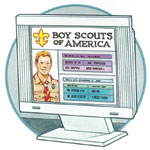
News Briefs
Jamboree-on-the-Air is scheduled for the third weekend in October
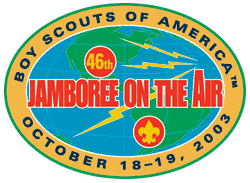
The 46th annual Jamboree-on-the-Air (JOTA), sponsored by the World Organization of the Scout Movement, will take place Oct. 18-19.
Thousands of amateur radio stations and nearly a half million Scouts and Guides will participate around the world. In the United States, some Cub Scouts and Boy Scouts participate as guests of local amateur (ham) radio operators. Other ham operators set up stations at BSA district and council events scheduled to coincide with JOTA.
JOTA frequencies are SSB (phone) 3.940, 7.290, 14.290, 18.140, 21.360, 24.960, and 28.390 MHz. CW (Morse code) frequencies are 3.590, 7.030, 14.070, 18.080, 21.140, 24.910, and 28.190 MHz.
Free wallet-size certificates are available from Jamboree-on-the-Air Certificate Cards, S221, 1325 W. Walnut Hill Ln., P.O. Box 152079, Irving, TX 75015-2079. Enclose a self-addressed, stamped envelope large enough to hold the number of cards ordered. All orders must be received by Jan. 31, 2004.
JOTA patches ($3.50 each, postpaid) are also available from the same address. Send check or money order, payable to Boy Scouts of America, by Jan. 31, 2004.
More JOTA information is available at www.scouting.org/international/jota.html.
A photo opportunity for troops
The BSA revises many merit badge pamphlets each year and seeks Scouts to perform fun activities mentioned in the text. This is a possible opportunity for troops whose membership represents ethnic diversity and whose Scouts enjoy hamming it up before a camera.
Troops should be willing to participate weekends, after school, or during summertime. Interested leaders should send a photo of your diverse and energetic troop with a contact name and number to Photo Opportunity, S314, Boy Scouts of America, P.O. Box 152079, 1325 W. Walnut Hill Ln., Irving, TX 75015-2079; or by e-mail to photo-op@netbsa.org.
National Scout jamboree volunteer staff positions are available
More than 7,500 adult and youth volunteers will serve as volunteer staff members for the BSA's 16th National Scout Jamboree, scheduled for July 25 to Aug. 3, 2005, at Fort A.P. Hill, Caroline County, Virginia.
Staff positions are open to men and women who are registered members of the Boy Scouts of America and were born before July 25, 1984. Youth staff members must be registered members of the BSA and born between July 25, 1984 and Aug. 3, 1989.
Jamboree staff provide support and program services in all areas. The greatest number of available positions is in food services, security/parking, and trading post services. The jamboree band is also looking for youth musicians.
Other areas of service include: Order of the Arrow shows, arena shows, boating, fishing, scuba, snorkeling, conservation, media, regional action centers, and subcamp staff services.
Adult staff members pay a fee of $595 to attend the jamboree; youth staff fee is $295.
Applications, which can be downloaded from the BSA Web site, www.scouting.org/jamboree., or obtained from local Scout council service centers, must be submitted through the local council office.
Council campaign promotes pride in the Scout uniform
Residents of the Buffalo, N.Y., area are noticing more Boy Scouts decked out in full uniforms in public. The surging number of uniformed Scouts is part of a campaign by the Greater Niagara Frontier Council to promote pride in local troops and help raise the overall visibility of Scouting.
Parents and volunteer leaders, as well as the Scouts, are solidly behind the effort, says Scout Executive Gary Butler. Since a campaign for full-uniform troops began in late 2001, 33 of the council's 171 active troops have qualified for the designation.
Cub Scouts have always been highly uniform-conscious, Butler points out, but many Boy Scouts—and their troop leaders—often slip into the habit of wearing only partial uniforms or no uniform at all.
"Typically, a Cub Scout can't wait to wear his uniform in public, to proclaim to everybody that he's a Cub Scout," says Butler. "We want to promote that same feeling of pride and team spirit in our Boy Scouts and adult leaders. By and large, the kids like to wear uniforms, but we've allowed some troops to get lazy and make excuses. We feel that sends the wrong message to the community, and we want to change that."
Members of each troop vote on the decision of whether to adopt the full-uniform policy, Butler says. The policy requires that each member and volunteer leader of the troop wear a full uniform for courts of honor, color guards and other ceremonial events. Activity uniforms (a Scout T-shirt or polo shirt with official uniform pants or shorts and socks) are allowed for less formal public appearances.
The council offers incentives, such as discounts on Scout pants and free manuals and other materials—paid for with grant funds—for participating troops. Each boy is expected to earn the money for his own uniform by taking part in troop money-earning projects, Butler says.
Units qualifying for the full-uniform designation come from all parts of the council, Butler says. "Actually, the number of full-uniform Scouts in our inner-city urban areas is higher than in the suburbs," he adds.
"Our goal is to have 100 percent of our troops fully uniformed, and I think we can do that."
—Bill Sloan
Volunteering has a positive impact on Scout leaders
A new survey, Volunteer Outcomes Study (BSA No. 02-658), conducted by Harris Interactive for the BSA, shows that adults can enhance or strengthen their skills and values as a result of serving as a Scouting volunteer leader.
The study aimed to identify the outcomes of adult volunteering. Volunteers were randomly selected to participate from 84 Scout councils, and a total of 16,124 individuals completed the survey.
- reinforce values already held by adult volunteers and provide an opportunity to act on those values
- increase participation in community service, enhance pride in the community and in being an American, and inspire more involvement in other organizations
- increase environmental awareness and develop or improve conservation skills
- enhance ethical and moral decision making through leadership activities
- improve patience and tolerance toward people who hold differing ideas and opinions
- provide enjoyment, reduce stress and anxiety, and help build self-esteem through setting and accomplishing goals
- improve communicating, teaching, and mentoring skills
- enable adults to become better parents, through the setting of positive examples for, and building a closer bond with, their children
- enhance abilities to be a positive influence on other people and to resolve conflicts
- increase physical activity and improve outdoor skills
- provide a sense of personal fulfillment and accomplishment, making them better managers and employees.
- Heart of America Council. "Neighborhoods in rubble" read a newspaper headline after F4 tornadoes smashed through Kansas and Missouri towns along the northern side of Kansas City on May 4. Troop 134 worked in their hometown of Liberty, Mo., then went to aid a family in Gladstone and found the entire subdivision needed help recovering belongings. "A lot of hard work was done by these unselfish Scouts and Scouters," a report said.
- West Tennessee Area Council. In Jackson, where an F4 tornado struck May 4, troops worked at a relief site unloading, sorting, and distributing food and other items. "The people in charge asked what we could do and how long we could stay, and they were surprised when we said whatever they needed done and however long it took," reported Troop 15 Scoutmaster John Robinson.
- Last Frontier Council. On May 8 and 9, F4 and F3 tornadoes touched down in towns around Oklahoma City. Some of the first to respond were Air Force personnel who are also Scouters from Pack 116 and Troop 116 at Tinker Air Force Base. In Choctaw, Troop 275 leaders used chain saws on downed trees, while Scouts removed brush and debris.
The study found that involvement as a Scouting volunteer helps to:
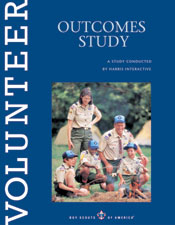
Ask for a copy of the study at council service centers, or download it from the BSA Web site.
Venturing Crews Producing a Flock of Eagles
Older Boy Scouts and their troop leaders are finding that today's road to the Eagle Scout Award often runs through a troop-affiliated Venturing crew.
The number of Eagle awards earned by boys who are registered as Venturers has shown substantial gains each year since 2000. During the year 2002, about one in every nine new Eagle Scouts—5,379 of 49,328 nationwide—earned Scouting's highest rank as members of a Venturing crew.
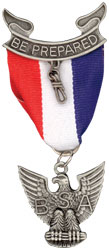
As a result, troops and chartered organizations are encouraged to play an increasingly active role in the forming of new Venturing crews, according to Bill Evans, associate director of the BSA's national Venturing Division.
"Troops are probably our No. 1 source of new Venturing crews," says Evans, "and there's a logical reason for this. Regular troop programs often aren't as attractive to many 16- and 17-year-old Scouts as they are to 12- and 13-year-olds. Establishing an affiliated Venturing program helps keep these older boys active in Scouting."
A boy must achieve a rank of at least First Class as a Boy Scout in order to continue on the road to Eagle after becoming a Venturer. Also, aspects of Venturing's advancement program, such as the requirements to teach certain skills to younger Scouts, helps to keep older boys involved in troop activities after they join a Venturing crew.
A unit, district, or council review is still required for Venturers to earn the Eagle Scout Award. However, Venturing candidates are not required to wear either a Boy Scout or Venturing uniform when appearing before their review board.
It is also recommended that Eagle boards of review include at least one member who is knowledgeable in the Venturing program.
—Bill Sloan
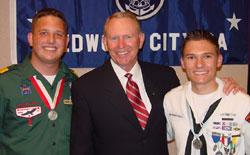 At the BSA National Annual Meeting in Philadelphia in May, Chief Scout Executive Roy L. Williams greeted two of the BSA's new national youth officers: National Venturing President Thomas Franklin (left), from the Sam Houston Area Council , Houston, Tex., and National Sea Scout Boatswain Chris Kerzich, from the Des Plaines Valley Council , La Grange, Ill. |
NUMBERS
290—Scouts from Massachusetts and Rhode Island who have earned the Stamp Collecting merit badge in the past four years through a program sponsored by the Spellman Museum of Stamps & Postal History in Weston, Mass. The one-day workshops, designed for 6 to 15 Scouts, cost $12 and include the use of museum materials, a packet of 50 stamps, and the merit badge handbook. For more information or to schedule a visit, call (781) 768-7343.
914—new Eagle Scouts honored by the Sam Houston Area Council, in Houston, Tex., at the annual Eagle Scout reception in March. The number of new Eagles for 2002 was the largest in council history.
5,966—commitments from potential chartered organizations to establish traditional Scouting units, reported by local councils on Feb. 5, 2003, during the BSA's national commitment day videoconference. "The success of the videoconference is a testament to the diligence and dedication of our professionals at every level," said Chief Scout Executive Roy L. Williams. (c)
45,200—pounds of food collected in the 2002 Scouting for Food Good Turn in the Marin Council, San Rafael, Calif. The total, delivered to the Marin Community Food Bank, exceeded the previous year's total by 2,200 pounds.
79,029—religious emblems earned by Cub Scouts, Webelos Scouts, Boy Scouts, and Venturers in 2002. The BSA Religious Relationships Committee oversees this program, in which various religious groups develop requirements and procedures for Scouting youth to earn the religious emblem of their faith.
$1.8 million—amount in sales reached by packs, troops, and crews in the Simon Kenton Council's 2002 Trail's End popcorn campaign. The Columbus, Ohio, council's all-time high of $1,812,526 in sales resulted in more than $542,000 added to unit checking accounts, with the Delaware District's Pack 318 No. 1 with $30,593 in sales.
After Tornadoes Hit, Scouts Were Ready to Serve
By Suzanne Wilson
When tornadoes struck many areas of the nation's midsection in May, the destruction was extraordinary. After twisters rated at F3 (severe damage) and F4 (devastating damage) touched down, Scouts were among the first to ask, "How can we help?"
Communities in the Ozark Trails Council were heavily hit. After an F3 tornado tore through Carl Junction, Mo., on May 4, Scouts and leaders from Troop 70 first went to "friends and family," including members of their chartered organization, First Christian Church of Carl Junction. They cleared tree limbs and debris, salvaged belongings and mementos, and went on to help wherever they were needed.
Aaron McGinn and Chris Leggett, both 13, worked 60 hours in the first week, sunup to sundown. The work fit well with Scouting. "Do a Good Turn daily," Chris said. Aaron added, "It's like in the [Scout] Oath, where it says 'help other people at all times.'"
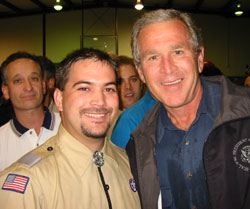 President Bush discussed service needs with district executive Matt Shroyer. |
The severity of the damage prompted President George W. Bush to visit the stricken region. During his stop in Pierce City, Mo., its historical area devastated by an F4 twister, the president told Matt Shroyer, Nih-Ka-Ga-Hah district executive: "We need you to get your Scouts out here to help these people."
Soon, not only local Scouts, but units from other towns came to clear yards outside the demolition area.
The experience was repeated from Oklahoma to Tennessee and beyond, as requests for assistance went out via Scouters' e-mail. Some troops drove 150 miles to volunteer. Cub Scout and Boy Scout units took assignments from emergency management and other agencies as well as the Red Cross.
Among the other countless acts of Scout support:
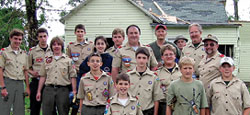 |
|---|
| In Pierce City, Mo., Scouts and leaders from Troop 36 (above) and Troop 10 (below) helped clear away tornado debris. |
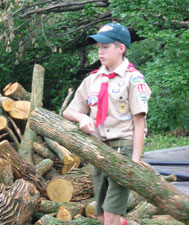 |
Scouts in these and other councils saw destruction akin to war zones and evidence of winds that could slam two-by-fours through walls and drive artificial flowers into tree trunks at a cemetery.
Many Scouts knew people who lost homes, businesses, even lives. In a time when the words too often heard were "they lost everything," Scouts were there to give back all they possibly could.
October 2003 Table of Contents
Copyright © 2003 by the Boy Scouts of America. All rights thereunder reserved; anything appearing in Scouting magazine or on its Web site may not be reprinted either wholly or in part without written permission. Because of freedom given authors, opinions may not reflect official concurrence.